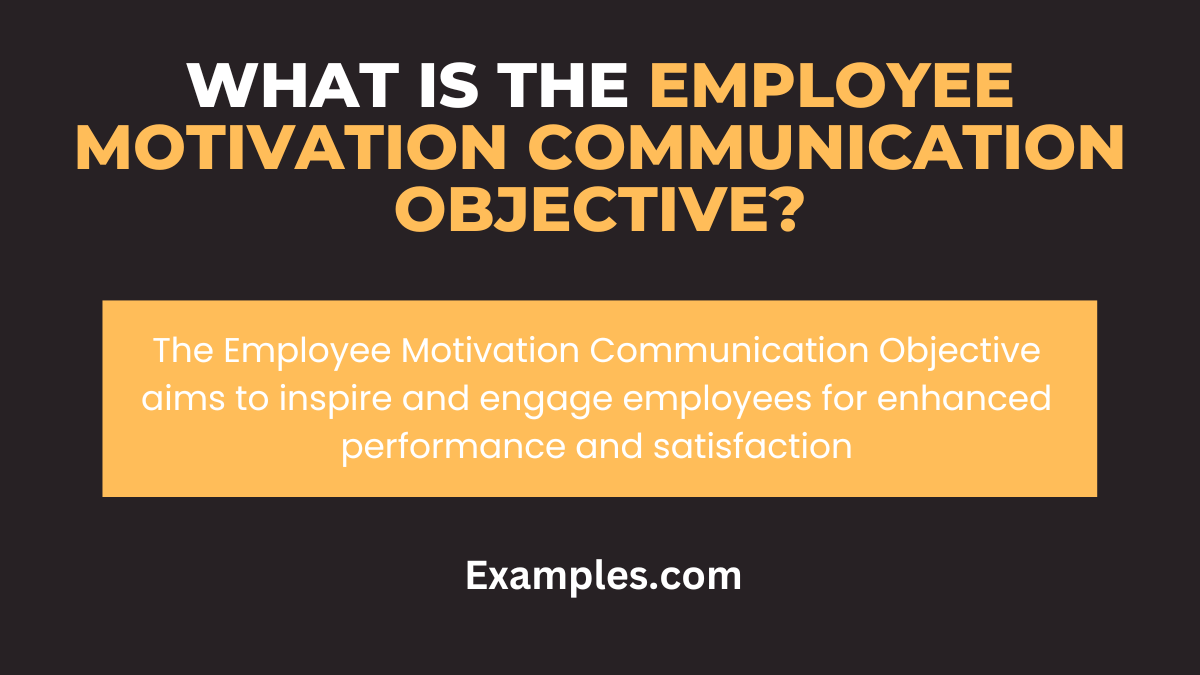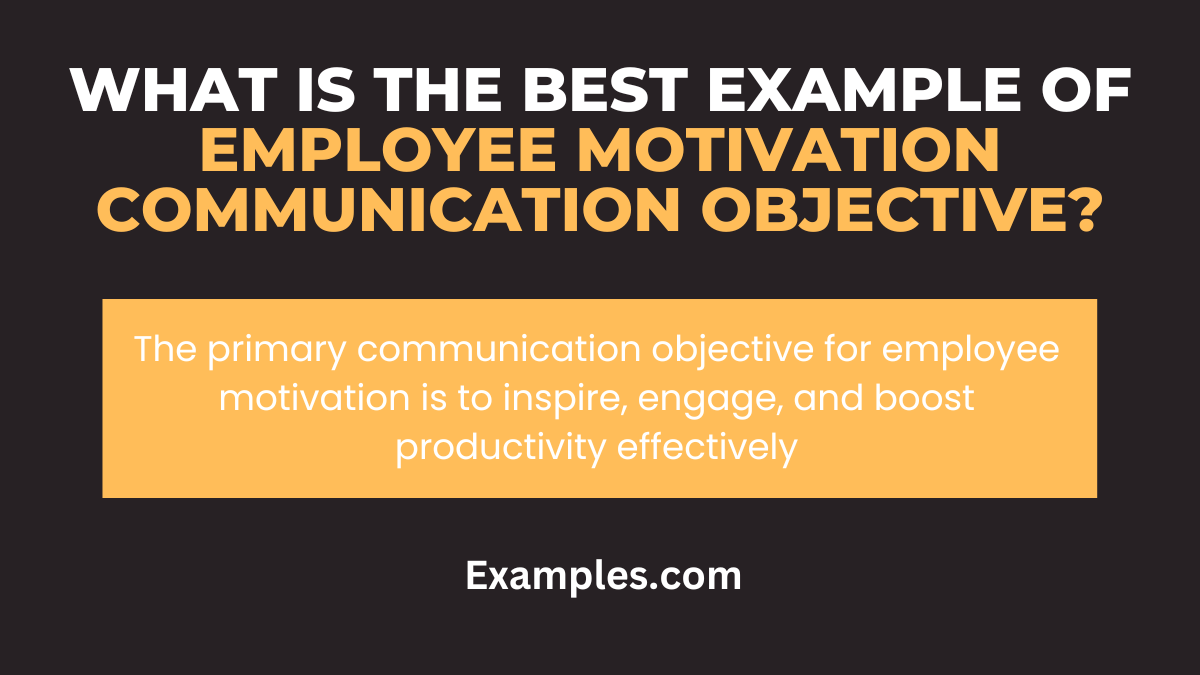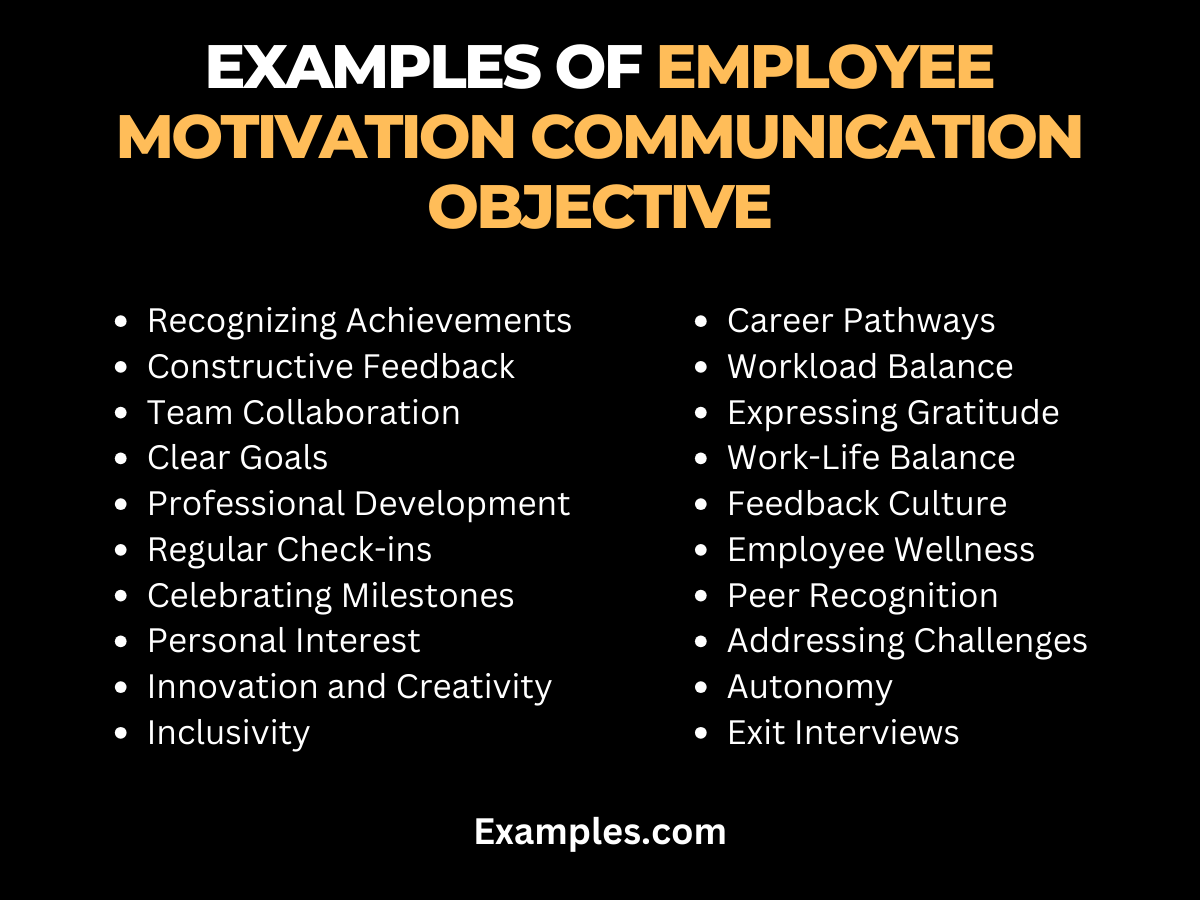19+ Employee Motivation Communication Objective Examples
Unlock the full potential of your team with our comprehensive guide on “Employee Motivation Communication Objective.” This essential resource delves into effective strategies for motivating employees through targeted communication. Discover how to craft messages that inspire and engage, fostering a productive and positive workplace culture. Elevate your communication skills to motivate your team towards excellence.
What is the Employee Motivation Communication Objective?

The Employee Motivation Communication Objective is a strategic approach aimed at using communication to enhance employee motivation. It involves crafting messages and interactions that inspire, encourage, and positively influence the morale and productivity of team members. This objective is vital in creating an environment where employees feel valued, engaged, and committed to their work.
What is the Best Example of Employee Motivation Communication Objective?

A prime example of an Employee Motivation Communication Objective is a communication strategy that includes regular, positive feedback, recognition of achievements, and clear, encouraging guidance on career development. This might involve personalized emails, team meetings highlighting individual and group successes, and workshops focused on career growth, all tailored to boost motivation and job satisfaction.
20 Examples of Employee Motivation Communication Objective

Effective communication plays a pivotal role in motivating employees. By setting clear, engaging, and inspiring communication objectives, leaders can boost morale, drive performance, and foster a positive work environment. These objectives should be tailored to address individual needs, recognize achievements, and encourage professional growth, ultimately contributing to a more motivated and productive workforce.
- Recognizing Individual Achievements: Acknowledging employees’ contributions publicly.
Example: “Great job on the project, Sarah! Your hard work really made a difference.” - Providing Constructive Feedback: Offering guidance for improvement in a supportive manner.
Example: “I appreciate your effort on this. Let’s work together on refining your approach for even better results.” - Encouraging Team Collaboration: Promoting teamwork through positive communication.
Example: “Your teamwork on this project has been outstanding. Keep up the great collaboration!” - Setting Clear Goals: Communicating objectives and expectations clearly.
Example: “Our goal for this quarter is to increase efficiency by 20%. Let’s discuss how each of you can contribute to this.” - Offering Professional Development Opportunities: Informing about training and growth prospects. Example: “We have a new training program that I think you’ll find enriching and beneficial for your career growth.”
- Regular Check-ins for Support: Having frequent, informal conversations about progress and wellbeing. Example: “How’s everything going? Let me know how I can support you in your current tasks.”
- Celebrating Team Milestones: Acknowledging collective achievements.
Example: “Our team hit the quarterly target! This is a fantastic achievement by everyone.” - Showing Personal Interest: Communicating care for employees’ personal and professional lives.
Example: “I heard you completed a certification recently, congratulations! How do you plan to apply your new skills?” - Encouraging Innovation and Creativity: Motivating employees to share new ideas.
Example: “I value your creative input. Let’s brainstorm on this together and see what innovative ideas we can come up with.” - Fostering an Inclusive Environment: Communicating inclusivity and respect for diversity.
Example: “Your unique perspectives add great value to our team. Let’s continue to embrace our diverse ideas.” - Highlighting Career Pathways: Discussing future roles and career progression.
Example: “You’ve shown great potential. Let’s talk about your career path and the steps you can take to reach your goals.” - Balancing Workload Effectively: Communicating to ensure manageable workloads.
Example: “Let’s review your current workload and see how we can make it more manageable for you.” - Expressing Gratitude: Showing appreciation for hard work and dedication.
Example: “Thank you for staying late last week to meet our deadline. Your dedication is truly appreciated.” - Encouraging Work-Life Balance: Discussing the importance of personal time.
Example: “Remember, it’s important to balance work with personal time. Let’s make sure you’re taking the time you need.” - Creating a Feedback Culture: Encouraging open and honest communication.
Example: “I value your feedback. Let’s keep the lines of communication open.” - Supporting Employee Wellness: Addressing physical and mental health in the workplace.
Example: “Your wellbeing is important. Let’s explore how we can support a healthier work environment for you.” - Promoting Peer Recognition: Encouraging employees to appreciate each other’s efforts.
Example: “Let’s take a moment to acknowledge our colleagues’ hard work and successes.” - Addressing Challenges Proactively: Communicating support in overcoming obstacles.
Example: “I see you’re facing some challenges. Let’s work together to find a solution.” - Encouraging Autonomy and Independence: Supporting employees in taking initiative.
Example: “I trust your judgment on this. Feel free to take the lead and show us your approach.” - Conducting Exit Interviews: Gathering feedback from departing employees to improve the work environment.
Example: “As you move on to your next opportunity, your insights on improving our workplace would be valuable.”
What is the Role of Communication in Employee Motivation?
- Enhancing Clarity and Direction: Clear communication provides employees with a sense of direction and understanding of their roles and responsibilities, boosting their motivation.
- Recognition and Appreciation: Communicating praise and recognition for achievements motivates employees by making them feel valued.
- Building Trust: Open and honest communication fosters trust, making employees feel more secure and motivated.
- Encouraging Feedback and Participation: Inviting feedback and ideas from employees makes them feel heard and respected, increasing their engagement and motivation.
- Promoting Team Collaboration: Effective communication encourages teamwork, creating a supportive environment that motivates individuals.
- Setting and Reinforcing Goals: Communicating clear goals and progress helps employees focus and align their efforts, enhancing motivation.
- Resolving Conflicts: Timely and effective communication can resolve conflicts, maintaining a positive work environment conducive to motivation.
- Providing Growth and Development Opportunities: Communicating opportunities for personal and professional growth motivates employees to strive for improvement.
How to Communicate Effectively to Motivate Employees?
- Be Clear and Concise: Use simple, clear language to avoid misunderstandings.
- Listen Actively: Show genuine interest in employees’ ideas and concerns.
- Give Constructive Feedback: Offer feedback that is specific, actionable, and positive.
- Recognize and Reward: Acknowledge achievements publicly and with sincerity.
- Maintain Regular Communication: Keep lines of communication open and regular.
- Tailor Your Message: Adjust your communication style to suit different employees.
- Encourage Open Dialogue: Create an environment where employees feel safe to express their thoughts.
- Use Multiple Channels: Utilize various communication methods to reach all employees effectively.
Employee Motivation Communication Objectives at Workplace
- Setting Clear Expectations: Communicate job roles, objectives, and performance standards clearly.
- Building a Positive Work Culture: Foster a culture of positivity and inclusivity through communication.
- Enhancing Employee Engagement: Use communication to involve employees in decision-making processes.
- Promoting Transparency: Share company news, changes, and decisions openly.
- Facilitating Continuous Learning: Communicate opportunities for training and development.
- Encouraging Peer-to-Peer Recognition: Promote a culture where employees appreciate and recognize each other’s efforts.
- Handling Change Effectively: Communicate about changes in the organization thoughtfully to reduce resistance and anxiety.
- Reinforcing Company Values and Goals: Regularly communicate the company’s vision, values, and goals to align employees with the organization’s direction.
Effective communication for employee motivation is vital. By fostering open dialogue, acknowledging contributions, and offering growth opportunities, employers can inspire and retain motivated teams. This guide provides valuable tips to create a workplace culture that promotes employee engagement and boosts overall productivity.



